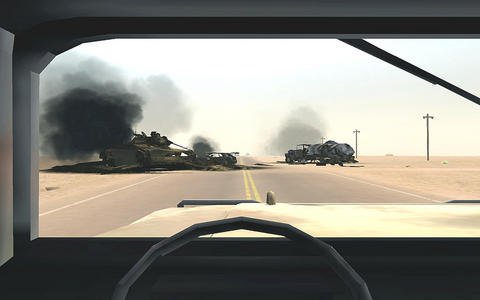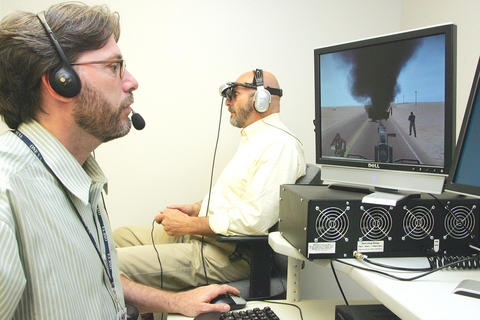The sun shines on an empty Iraqi street. A Black Hawk helicopter circles overhead. The aromas of spices from a market fill the air.
Suddenly, insurgents hiding on a roof launch a rocket-propelled grenade. The ground shakes violently and plumes of black smoke cloud your vision.
Those images, produced when a person puts on a headset, are at the heart of Virtual Iraq, a simulation created to treat Iraq War veterans suffering from post-traumatic stress disorder.

PHOTO: NY TIMES NEWS SERVICE
By repeatedly encountering sights, sounds, smells and rumblings that evoke painful memories, experts say, veterans with the disorder can begin to reprocess traumatic events and become desensitized to them, perhaps suffering fewer side effects like insomnia, nightmares and flashbacks.
The simulation is available to a small number of patients.
So-called exposure therapy, in which patients are asked to confront memories of a trauma by imagining and recounting it in painstaking detail, has long been a first-line psychological treatment for post-traumatic stress disorder (PTSD). But the bells and whistles of virtual reality may make exposure therapy more effective, said Michael Kramer, a clinical psychologist at the Veterans Administration hospital in Manhattan who is overseeing the introduction of Virtual Iraq there.

PHOTO: NY TIMES NEWS SERVICE
"One of the hallmarks of PTSD is avoidance," Kramer said. "Patients spend an awful lot of time and energy trying not to think about it or talk about it. But behaviorally, avoidance is what keeps the trauma alive.
"With virtual reality, we can put them back in the moment. And we can do it in a gradual, controlled way."
Virtual Iraq features two scenarios. In one, patients navigate the streets of a generic Iraqi city, walking past buildings, cars, civilians and markets. With the touch of a therapist's keypad, a little boy might appear on a street corner and wave, apparently in friendship, or a man might stumble down the middle of the street calling for help, a sight that provokes anxiety in some veterans who have come to fear ruses.
In the other scene, veterans ride in a Humvee. Other vehicles might slow down in front of them and strangers might open fire. Enemy combatants might appear under bridges. Objects dotting the roadside might explode as the Humvee passes.
The patient cannot shoot back at the insurgents and also cannot die or be wounded in the simulation.
In choosing which stimuli to introduce, the therapist's goal is to evoke the conditions present when specific traumatic events occurred, as accurately as the simulation will allow. Smells like spices, burning garbage or body odor can be emitted in four-second puffs. And the scene can be set to day or night, sun or fog or even a sandstorm.
Given the power of traumatic memories, Kramer said, it is important "to go at a pace that the veteran can tolerate, so that he isn't overwhelmed," and he starts to realize that the memories cannot harm him.
One risk of introducing potent material too fast is that a veteran could become re-traumatized and perhaps unwilling to continue other kinds of therapy, as well.
Not all patients with the stress disorder are likely to benefit from this therapy. Veterans who lack basic coping mechanisms, are actively having flashbacks or who have unaddressed problems with substance abuse should probably not enter the simulator, Kramer said.
"It's a hard treatment for a very hard problem," said Albert Rizzo, the director of the Virtual Environments Lab at the University of Southern California.
Rizzo first created a simulation for Iraq veterans with the disorder in 2003, by modifying the Xbox game Full Spectrum Warrior. In 2004, he and Ken Graap, president and chief executive of Virtually Better in Decatur, Georgia, received financing from the Office of Naval Research to develop the current simulation, with extensive feedback from veterans and active-duty members of the military.
Virtually Better also offers a Virtual Vietnam, as well as programs to address fears of heights and flying, social phobias and addictive behaviors.
Exposure therapy may not be enough for veterans with complicated symptoms resulting from chronic stress and multiple traumatic episodes, said Rachel Yehuda, director of the post-traumatic stress disorder program at the James Peters Department of Veterans Affairs Medical Center in the Bronx.
"I don't believe," she said, "that any study of exposure therapy for combat-related PTSD has shown a clinically significant improvement" in more than half the patients.
"While I would offer it to a veteran in a heartbeat, I would be prepared for the fact that it might have to be supplemented with other forms of assistance" like medication and social services, she said.
"If we're too enthusiastic," Yehuda added, "then people may expect veterans to be cured after 12 weeks, and it just doesn't work that way."
Hunter Hoffman, a cognitive psychologist at the University of Washington in Seattle, said: "With the growing ranks of Iraq War veterans who have developed PTSD, now is the time for them to receive effective treatment, not 20 years from now.
"We know from Vietnam that for most patients diagnosed with PTSD, these problems don't just go away over time."

April 28 to May 4 During the Japanese colonial era, a city’s “first” high school typically served Japanese students, while Taiwanese attended the “second” high school. Only in Taichung was this reversed. That’s because when Taichung First High School opened its doors on May 1, 1915 to serve Taiwanese students who were previously barred from secondary education, it was the only high school in town. Former principal Hideo Azukisawa threatened to quit when the government in 1922 attempted to transfer the “first” designation to a new local high school for Japanese students, leading to this unusual situation. Prior to the Taichung First

The Ministry of Education last month proposed a nationwide ban on mobile devices in schools, aiming to curb concerns over student phone addiction. Under the revised regulation, which will take effect in August, teachers and schools will be required to collect mobile devices — including phones, laptops and wearables devices — for safekeeping during school hours, unless they are being used for educational purposes. For Chang Fong-ching (張鳳琴), the ban will have a positive impact. “It’s a good move,” says the professor in the department of

On April 17, Chinese Nationalist Party (KMT) Chairman Eric Chu (朱立倫) launched a bold campaign to revive and revitalize the KMT base by calling for an impromptu rally at the Taipei prosecutor’s offices to protest recent arrests of KMT recall campaigners over allegations of forgery and fraud involving signatures of dead voters. The protest had no time to apply for permits and was illegal, but that played into the sense of opposition grievance at alleged weaponization of the judiciary by the Democratic Progressive Party (DPP) to “annihilate” the opposition parties. Blamed for faltering recall campaigns and faced with a KMT chair

Article 2 of the Additional Articles of the Constitution of the Republic of China (中華民國憲法增修條文) stipulates that upon a vote of no confidence in the premier, the president can dissolve the legislature within 10 days. If the legislature is dissolved, a new legislative election must be held within 60 days, and the legislators’ terms will then be reckoned from that election. Two weeks ago Taipei Mayor Chiang Wan-an (蔣萬安) of the Chinese Nationalist Party (KMT) proposed that the legislature hold a vote of no confidence in the premier and dare the president to dissolve the legislature. The legislature is currently controlled